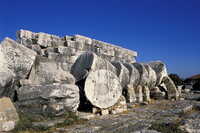| dc.coverage.spatial | Site: Didyma, Aegean Region, Turkey | en_US |
| dc.coverage.temporal | 7th century BCE-2nd century CE (inclusive) | en_US |
| dc.creator | unknown (Greek (ancient)) | en_US |
| dc.date | -700-300 | en_US |
| dc.date.accessioned | 2013-03-20T18:05:37Z | |
| dc.date.available | 2013-03-20T18:05:37Z | |
| dc.date.issued | -700-300 | en_US |
| dc.identifier | 202240 | en_US |
| dc.identifier.other | archrefid: 1100 | en_US |
| dc.identifier.uri | http://hdl.handle.net/1721.3/110002 | |
| dc.description | Pronaos, fallen column, west flank; Ancient Greek oracular sanctuary on the west coast of Asia Minor (now Turkey), which flourished from the 7th century BCE to the 2nd century CE. The site is on an exposed peninsula 75 m above sea level, about 20 km south of Miletos. The mythological founder of the oracle was the shepherd Branchos, who received the gift of prophecy from Apollo. During the 6th century BCE, under the 'Branchidai' dynasty of priests, Didyma became the most important oracular sanctuary in East Greece, and was linked to Miletos by a Sacred Way 6 m wide and about 24 km long. In 334 BCE Alexander the Great liberated Miletos from Persian domination, and at least from the time of its endowment by Seleukos Nikator (ca. 300 BCE) Didyma was under Milesian control. Around 100-101 CE the Sacred Way within the sanctuary was paved by Trajan, and in the 2nd century CE a market and a basilica were constructed. Around 250 CE the peristyle of the Temple of Apollo was walled in, presumably to counter attacks by the Goths, turning it into a fortress. Earthquakes in the 13th century and in 1493 effectively destroyed the site. Source: Grove Art Online; http://www.groveart.com/ (accessed 2/1/2008) | en_US |
| dc.format.medium | stone | en_US |
| dc.rights | © Scott Gilchrist, Archivision, Inc. | en_US |
| dc.subject | architectural exteriors | en_US |
| dc.subject | Alexander, the Great, 356-323 B.C. | en_US |
| dc.subject | Roman Empire | en_US |
| dc.subject | Hellenistic | en_US |
| dc.subject | Greco-Roman | en_US |
| dc.title | Didyma [site] | en_US |
| dc.title.alternative | Branchidai | en_US |
| dc.type | image | en_US |
| dc.rights.access | Licensed for educational and research use by the MIT community only | en_US |
| dc.identifier.vendorcode | 1A3-G-DI-C8 | en_US |
| vra.culturalContext | Greek (ancient) Ancient Roman | en_US |
| vra.technique | carving (processes) construction (assembling) | en_US |
| vra.worktype | excavation (site) | en_US |
| vra.worktype | temple | en_US |
| dc.contributor.display | unknown (Greek (ancient)) | en_US |


